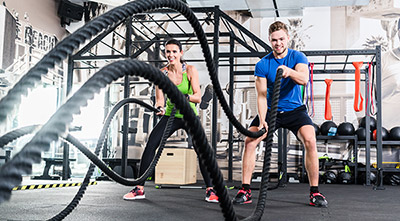Workouts that Work—Try Skill-Based Functional Fitness
September 21, 2016
From the perspective of our genetic history, we can see that we evolved from ancestors that were extremely active. Our hunter/gatherer predecessors literally moved to live.
But due to the conveniences of modern life, we no longer rely on those daily movement skills, so our bodies don’t function as well. That’s what makes functional training so valuable.
What is functional training?
Like strength training is intended to improve your physical strength, functional training is intended to improve how well your body functions. Those functions are the movement patterns of an active human life: pushing, pulling, carrying, lifting, going around obstacles, jumping, etc.
This same approach to training can also be intensified or expanded upon to replicate the movements required for specific activities or elite athletes—it’s a broad, skills-based approach, centered on developing a healthy fitness level for your particular needs and goals.
What about how I look?
Functional exercises have a reputation for improving performance, but trainers and coaches know there’s more to the approach than building skills. If you’re working out to improve your appearance, functional training can help in that department, too.
Not only will you still be building strength, endurance and flexibility, you’ll also be working against the effects of the sedentary lifestyle that defines modern times. Those effects include slouching from hours at a desk, slumped shoulders from being tethered to our computers and phones, and the inevitable weight gain that comes from driving everywhere, or the soft middle that comes from rarely having to lift or carry anything.
How does it work?
The same exercises used in a regular strength and conditioning session are often part of a functional training session. That includes straightforward exercises like squats, lunges and pushups as well as work with accessories like kettlebells and ropes. The main differences can be found in how the movement is performed, and under what conditions.
Functional training sees your whole body in 3-D, and the motions relate to real-life conditions such as reaching while on one foot or pushing something up over your head. As your ability to function with complex, total-body exercises improves, so will your movement skills like your agility while hiking with a heavy pack to how well you throw a baseball.
Other benefits from a functional training approach include more energy as you move more efficiently, more confidence in your activities, and a general reduction in aches, pains and injuries. Sound good? Try swapping out some of your traditional exercises with more functional ones like these:
- Progressive Pushups: Adding challenges like lifting a leg or holding a plank takes your standard pushups to the functional level, like getting up from the ground or pushing a large piece of furniture forward. Here are 8 Great Ways to Chance Up Your Pushups
- Jump Rope Cardio: Swap out time on the treadmill for time with a jump rope. When you become more skilled at jumping rope, you’ve increased your coordination and refined your quick movement skills, one reason boxers rely on jump ropes for their training sessions. You can hop on 1 foot, cross the rope over your body and perform speed jumping to upgrade your general stamina and grace.
- Dumbbell Carries: When you pick up heavy things and carry them around with control, it good work for your back and abs—in other words, your core. Pick up two heavy dumbbells or kettlebells and move around holding them at your sides, or hoisting them up to your shoulders. Swap this in for a couple Pilates exercises to help your posture and fluidity of movement even more.
- X-IT or StudioX Sessions: Try adding X-IT or StudioX sessions to your workouts. Both incorporate functional training techniques that can help improve your level of fitness. Click here to try a calories burning X-IT session or click here for a strength building StudioX workout of your choice.